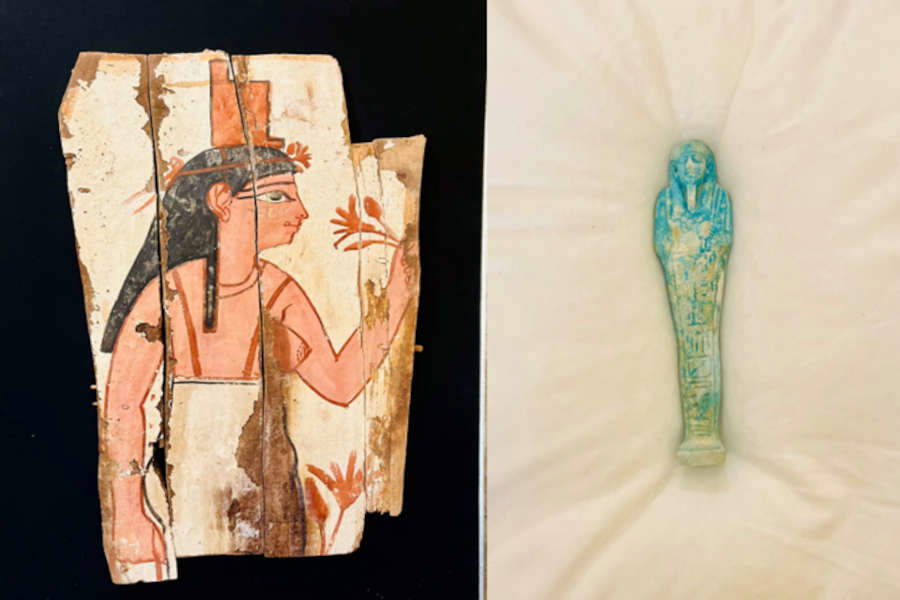Netherlands returns three illegally taken artifacts to Egypt
The Netherlands in recent days returned toEgypt three archaeological artifacts that had been illegally exported from the African country. Handing over the three objects to the Egyptian ambassador to the Netherlands, Hatem Elsayed Mohamed Kamaleldin, were Laurens Schouten, chief inspector of cultural heritage at the Inspectie Overheidsinformatie en Erfgoed (Government Inspectorate for Information and Heritage), and Maurice Stevens, head of art and antiques crimes at the National Police. Dewi van de Weerd, ambassador for international cultural cooperation at the Ministry of Foreign Affairs, was present. The three artifacts were returned through the joint efforts of the Dutch police, the Dutch Public Service, the Government Inspectorate for Information and Heritage, the Dutch Ministry of Foreign Affairs, and various Egyptian and Dutch experts. All the objects were voluntarily transferred by their owners for return. The return of these objects, the Inspectorate notes, symbolizes the close cooperation between Dutch and Egyptian authorities in the protection and preservation of cultural heritage.
The objects were recovered during several investigations. Two of them, a shabti (small statuette that was part of the grave goods) accompanying the burial of Ipethemetes from Thebes, and believed to date from about 664-525 B.C. (XXVI dynasty ), and a painting of the goddess Isis dating from about 30 B.C. - 642 AD (Roman period), were illegally exported from Egypt after 2014. Through the investigation of Dutch police, these objects were discovered among the holdings of a Dutch art dealer. Following the discovery, the dealer voluntarily transferred the two artifacts to the Dutch government and they have now been returned to Egypt by the Inspectorate, in accordance with the 1970 UNESCO Convention on Measures to Prohibit and Prevent the Illicit Import, Export and Transfer of Ownership of Cultural Property. A third object, a mummified head dating from around 170-45 B.C., had been in a collection in the Netherlands for many years (the Netherlands, moreover, chose not to make any photographs of this head available since they are human remains). After contacting the police, the collector’s heir surrendered the object and agreed to its return.
These archaeological objects are important to Egypt’s cultural heritage, the Inspectorate points out. Egypt, one of the world’s oldest civilizations, has a very rich cultural heritage, but this wealth puts the country at risk of illegal excavation, theft, and looting. International cooperation is the only way to combat these threats and ensure that illegally exported objects are returned to their country of origin. In the case of two of the returned objects, the source documentation contained strong indications that they had been illegally exported.
Like the Netherlands, Egypt has adopted the 1970 UNESCO Convention and has extensive national legislation aimed at protecting its cultural heritage. The 1970 Convention requires states to take preventive measures regarding illegal exports, cooperate internationally to combat illegal trade, and encourage state-to-state returns.
In the Netherlands, customs authorities, the Government Information and Heritage Inspectorate and the police work closely together to achieve this goal. The Ministry of Foreign Affairs is involved in the restitution process from a diplomatic and international cooperation perspective. Museums and universities also contribute their expertise by determining the authenticity of the objects as well as their cultural and historical significance. The return of these objects serves, the inspectorate notes, “to strengthen our joint efforts to protect national heritage and comply with international conventions, thus ensuring that the heritage is available for future generations.”
 |
| Netherlands returns three illegally taken artifacts to Egypt |
Warning: the translation into English of the original Italian article was created using automatic tools. We undertake to review all articles, but we do not guarantee the total absence of inaccuracies in the translation due to the program. You can find the original by clicking on the ITA button. If you find any mistake,please contact us.





























